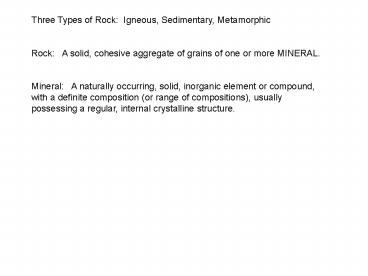Three Types of Rock: Igneous, Sedimentary, Metamorphic - PowerPoint PPT Presentation
1 / 35
Title:
Three Types of Rock: Igneous, Sedimentary, Metamorphic
Description:
Three Types of Rock: Igneous, Sedimentary, Metamorphic. Rock: A solid, cohesive ... Three Types of Rock: Igneous, Sedimentary, Metamorphic ... – PowerPoint PPT presentation
Number of Views:1395
Avg rating:3.0/5.0
Title: Three Types of Rock: Igneous, Sedimentary, Metamorphic
1
Three Types of Rock Igneous, Sedimentary,
Metamorphic Rock A solid, cohesive aggregate
of grains of one or more MINERAL. Mineral A
naturally occurring, solid, inorganic element or
compound, with a definite composition (or range
of compositions), usually possessing a regular,
internal crystalline structure.
2
Three Types of Rock Igneous, Sedimentary,
Metamorphic Rock A solid, cohesive aggregate
of grains of one or more MINERAL. Mineral A
naturally occurring, solid, inorganic element or
compound, with a definite composition (or range
of compositions), usually possessing a regular,
internal crystalline structure.
Example Rock Granite Minerals Quartz,
Feldspars, Biotite, etc.
3
CRYSTAL - A mineral grain displaying the
characteristics of its atomic structure. -
almost 4000 different kinds of minerals -
differences result from the different elements
used and the ways they are bonded
4
(No Transcript)
5
BULK COMPOSITION OF THE EARTH Element
Weight Iron (Fe) 35 Oxygen (O) 30 Silicon
(Si) 15 Magnesium (Mg) 13 Nickel (Ni)
2.4 Sulfur (S) 1.9 Calcium (Ca)
1.1 Aluminum (Al) 1.1
6
COMPOSITION OF THE EARTH'S CRUST Element
Atoms Weight Volume Oxygen
(O) 62.6 46.6 91.7 Silicon (Si) 21.2 27.7
0.2 Aluminum (Al) 6.5 8.1 0.5 Iron (Fe)
1.9 5.0 0.5 Sodium (Na) 2.6 2.8
2.2 Calcium (Ca) 1.9 3.6 1.5 Magnesium
(Mg) 1.8 2.1 0.4 Potassium (K) 1.4
2.6 3.1
7
Early Earth?
8
WHY DO MINERALS FORM? (Why not just separate
elements?) ? Need to understand the chemistry of
atomic bonding
9
Chemistry Review An ELEMENT is determined by
the number of PROTONS (). IONS - Atoms where
the number of ELECTRONS (-) have been added or
subtracted. ISOTOPES - Atoms where the number
of NEUTRONS have been added or subtracted.
10
Changing Model of the Atom
11
Changing Model of the Atom
12
Changing Model of the Atom
13
Changing Model of the Atom
14
Changing Model of the Atom
15
Chemical Bonds Forces that keep atoms
together Bonds are strong when the electron
orbitals (shells) are complete. of electrons
in Total of Orbital electrons 2
2 8 10 8 18 18
36 18 54 Etc.
16
IONIC BOND Ex Halite (salt)
17
IONIC BOND Ex Halite (salt)
Q Which is Na? Cl?
18
IONIC BOND Ex Halite (salt)
Q Which is Na? Cl? A Cl is larger
19
(No Transcript)
20
COVALENT BOND Ex Diamond
21
(No Transcript)
22
METALLIC BOND Electrons are free to move about
between atoms
23
For a Mineral to be Stable 1. Ionic charges sum
to ZERO 2. Ion sizes must be compatible (sizes
determined by electron cloud)
24
(No Transcript)
25
(No Transcript)
26
TEMPERATURE and PRESSURE play defining roles in
establishing the stability of the STATES (gas,
liquid, solid) and SOLID PHASES of minerals Ex
Water
27
(No Transcript)
28
Q. Why are there different forms of ice at
different temperatures and pressures?
29
Q. Why are there different forms of ice at
different temperatures and pressures? A. Because
the ion sizes change, relative to each other, at
different T P, so the ideal packing changes.
30
Ex Quartz (SiO2)
31
Most rocks are variations on silicon and oxygen
silicates
32
Silica Tetrahedron
33
Different silicate structures single tetrahedra,
single chains, double chains, sheets, 3D
structures (other atoms fill in the spaces in
between).
34
Slightly changing the different elements that
combine with silica greatly changes the mineral
that results, or the characteristics of the
mineral. Ex/ Different forms of quartz
35
The ROCK CYCLE































